Friday I get the call that my part is in. I think a weekday would probably grant a less crowded border crossing, so I decide to stay the weekend in Lake Jackson. The following day, on my drive to to pick up my part in Houston, I realize just how bad the air pollution is in this city. Coming from 50 miles out in the country, I can compare the difference in air quality. It hits me all at once. At first, I think there’s a smoky diesel on the road ahead of me. It’s so bad, at times I hold my breath. There is in fact no diesel truck, it’s just the normal air entering the city. Houston has some redeeming qualities, though. There are a number of fine museums, and quite a few awesome people I’ve met who live and play there.
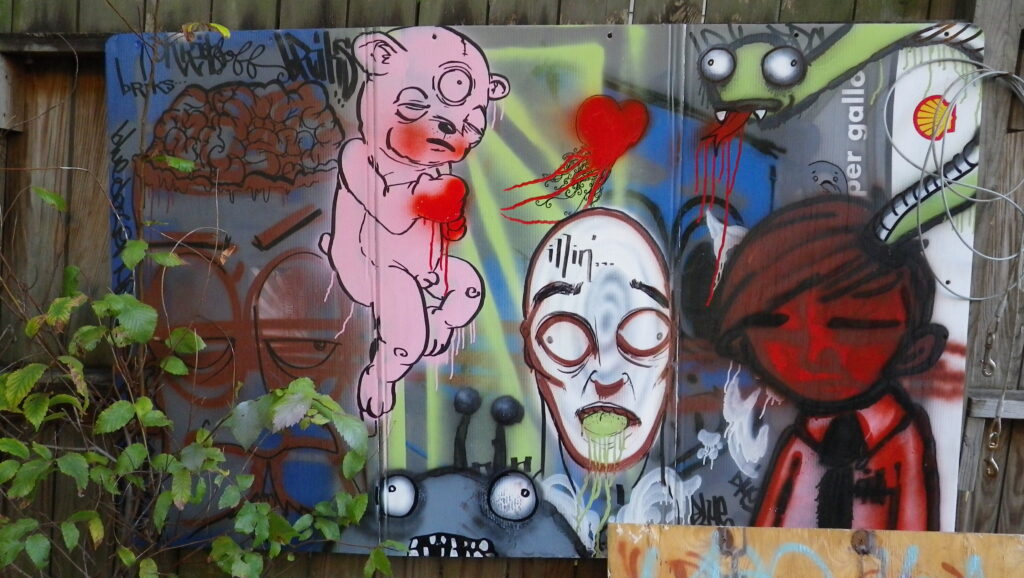
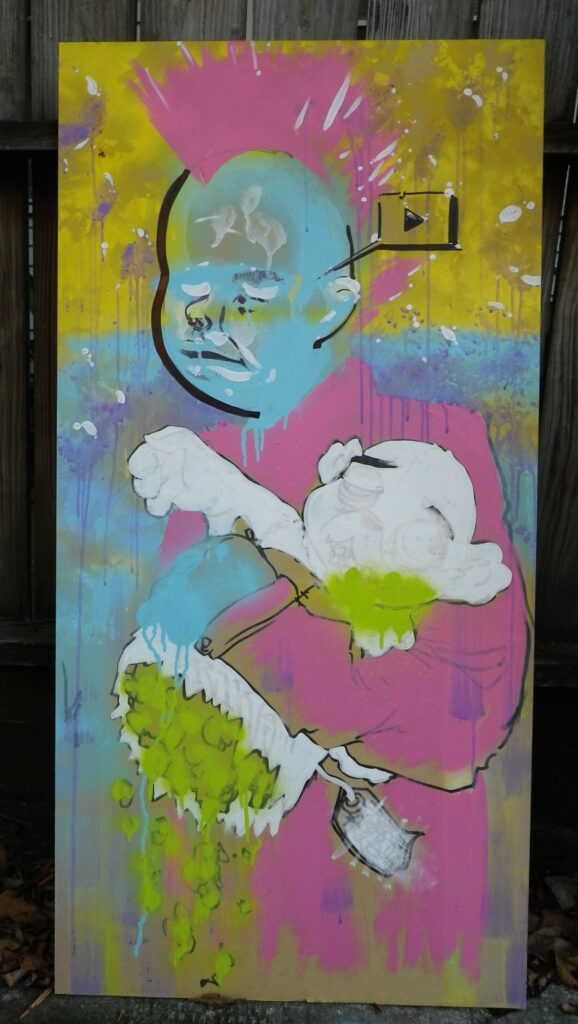
It’s a relaxing weekend. I’ve caused john to go nearly broke with my visit, so we take it easy. Monday morning I pack my bike like usual, but this time there are two additional tires to throw on top; literally. My GPS powers up with a route I planned the night prior, which will navigate me to the border. I intend to camp for the night to get an early start through the border. The first stop is the Texas Welcome/Information Center, outside Brownsville, to use their internet to download a PDF of my Mexico motorcycle insurance. I jet across the street to Office Depot to print it before hustling to get moving again for a cool breeze. Well, Texas doesn’t have any cool mid-day breeze out here, but my sweat evaporating makes it feel cool.
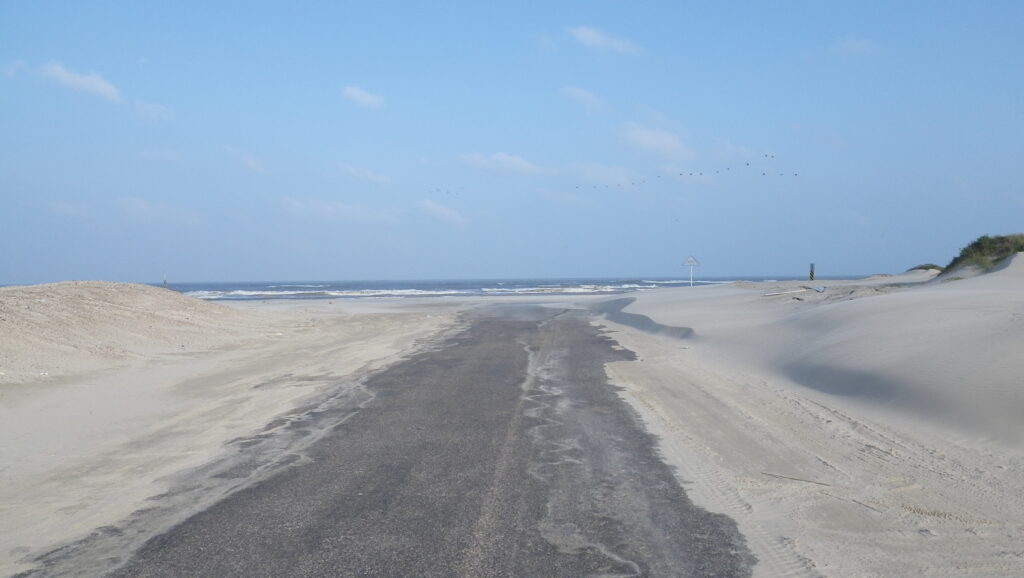
The main road for Boca Chica State Park ends at the beach, a few miles north of the Río Grande, the Mexican border. I was pleased to discover, last week, camping is permitted on all State Park beaches in Texas. The bike is hard to manage with its top-heavy load and street-oriented tires. I’m not surprised when I lose traction with the front tire and it goes down, like a pig on a pillow. I was trying to position the front toward the wind and didn’t lean properly with it when it began slipping to the side. It’s way too heavy to lift by myself with all the top gear still attached. I try once anyway just to see. I’ve got nothin! Maybe I need to practice squats. When most of the bags come off it’s a cake to get back up. I should really pack this light all the time, but I’m sticking with my prior choices until I see a need to cut things out. Once the knobbies go on, I’ll be a lot less top-heavy.
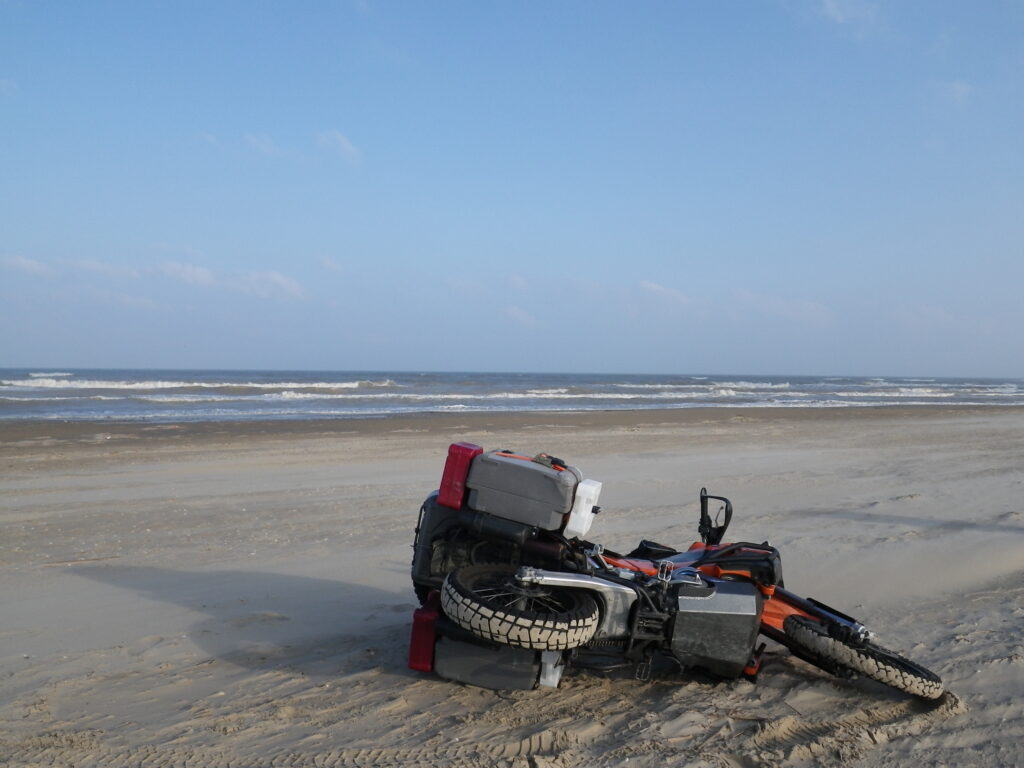
The wind on this beach is incredible. My idea of sleeping bare-back on the sand is not an option. I’d be buried by morning. Assembling my tent in this sand-swept wind is not an easy feat. Somehow I carefully stake, raise and secure the tent and rain-fly without getting too much of the powdery sand inside. I know I’ll have to be careful with the vents because this sand, like Florida sand, is very fine and can easily penetrate my noseeum netting. While patting everything down before taking it into the tent, I’m reminded of what some of my friends have said about the dust at Burning Man, and how it gets everywhere and is very difficult to rid yourself of it after you leave the Playa. I lie back and notice something odd. I move around a bit. Hmm. I don’t have my Indian blanket or sleeping bag under me, but it’s comfortable. A little movement is all it takes to form-fit my back into the earth and I’m sent into a slumber. My sleep is interrupted a few times throughout the night by border patrol officers driving by. I rehash my Great Smoky Mountains experience as I watch them continue down the beach.
I knew sand was still making its way in, despite my efforts to be conservative with venting, but I didn’t expect to see what I encountered in the morning. There’s minimal sand inside the tent, but I see my once semi-see-through vents are now opaque and bulging. I open the front flap to find my boots now have a layer of sand enveloping them with a liking to a powdered snowfall.
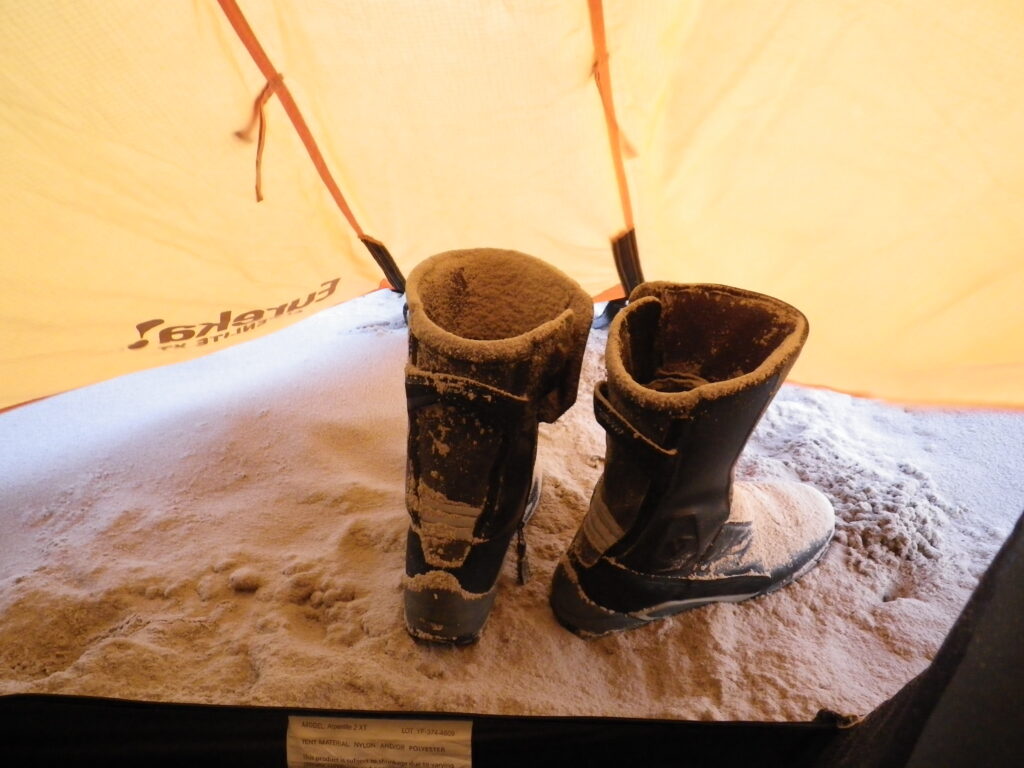
I find the same sanddrift outside around my bike and tent. With its relentless efforts throughout the night, sand managed to collect between the mesh netting and zippered vent flaps, and has now turned them into sand bags. The three rear vents that are facing the wind seem to have taken the worst of it. The rain fly and rear of the tent are completely covered.
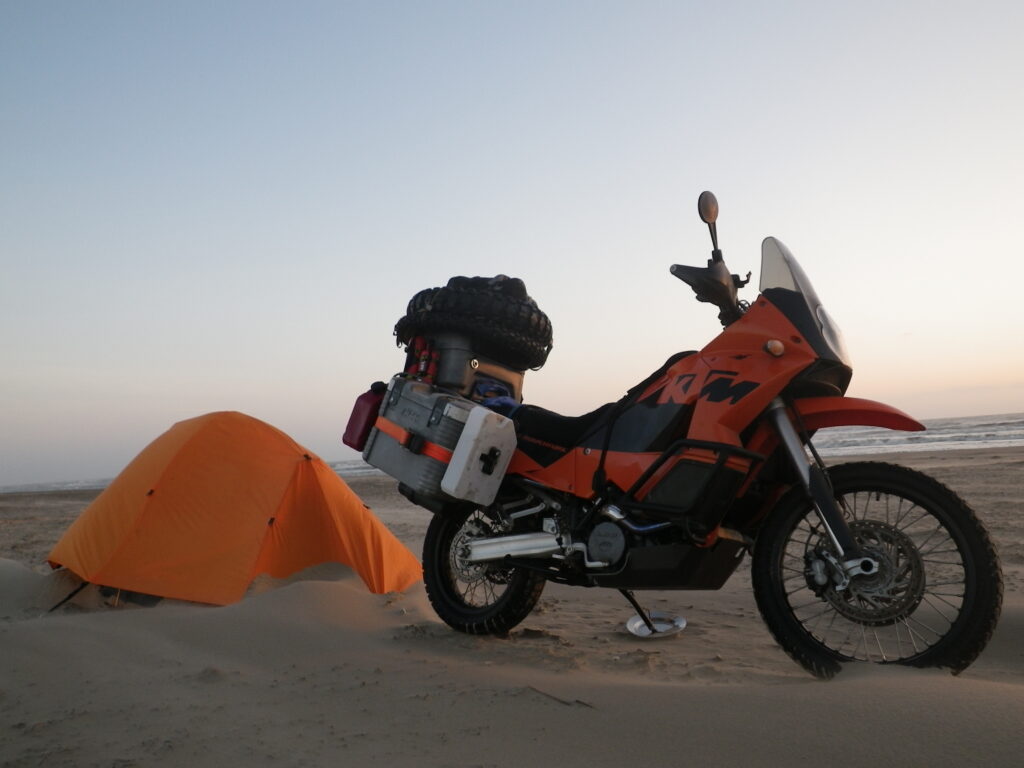
Cleaning and storing my tent in this sandy wind is going to be a huge pain in the ass. I break down the poles and hold up the tent for the wind to liberate some sand from its nested bowels. When I’m satisfied I have most of the sand out, I lightly pack it, unfolded, into my bag and drive to calmer ground. Back on the paved road, I dump another 5-10 pounds of sand before I think it can be safely stored.

The Boca Chica Café charges me for the day with a breakfast of beans, tortillas, eggs, and vegetables. A quick stop at Home Depot gets me a cable to lock my tires to my bike’s frame, and minutes later, I’m crossing the Río Grande. The excitement of my first solo border crossing is stifled by the heat when I’m signaled by a loud siren and stopped by border guards to check my papers. I needed to park anyway to get my tourist visa and temporary vehicle importation permit. This is where I’m met by my first border helper, who, for a fee, will guide you through the paperwork of entering Mexico. I have a good handle on the procedure and thank him for his offer. I get my bill from Migración and use one of the many copy booths to make duplicates of my passport, driver’s license, and registration. All these I take with my pre-registration code for my vehicle importation permit to the Banjercito, where I pay ~400 pesos for my visa (~$32 USD). As the cashier is finalizing the paperwork, a man runs up and tells me the wind has blown my bike over. I rush out to find no major damage, but a small amount of fuel spilled and the right turn signal popped out. It takes me and the helper from earlier to lift it from the concrete. Though, it does take the aid of the man who informed me of the accident to get the bike onto its center stand. I pull out my adjustable wrench and give my kickstand the last 360° turn it will take, shortening it another 1/2 cm (Kudos, CJDesigns). Removing a screw from the turn signal allows me to dissect it and secure it back on the bike as good as it was. There’s something to admire about mechanical design that prevents damage instead of making the purchase of new parts necessary. The paperwork is finished when I return. After taking my receipt of payment back to Migracion, my visa is official, and I head into my Matamoros. I’m on the lookout for a casa de cambio, or a house of change, to exchange my US Dollars for Pesos. Not too far from the border I spot one (making sure it has a reasonable exchange rate). Credit cards are not accepted, so I convert some cash I withdrew in the US into Pesos. I have a short conversation with a boy admiring my bike, from the hair salon next door, before venturing through the city.
Here first impressions of Mexico are a little unexpected. Traffic is not always fast or orderly. Vehicles act more like grains of sand in an hour glass. Every space is filled with cars, trucks, and motorcycles when a blockage is approached. Smaller vehicles have the advantage of speed and maneuverability, and passing in a no passing zone is common. Passing anywhere is common, for that matter. At the city center I move past a couple dozen soldiers in camouflage, bulletproof protective gear armed with high-powered rifles. A few hold larger guns attached to their trucks, pointed at me and others in traffic. This is a reoccurring sight, I’ve come to warm up to. What was at first fear turns to an odd type of safety; having guns pointed at me for my protection, that is. It makes me contemplate their necessity to be here.
Once out of the city, I’m hit with the same gusty winds that kept me and my bike tilted through the last 200 miles of Texas. It’s refreshing in the now afternoon sun, and I manage to find a nice riding groove. I enjoy the quaint ranchitos on the roadside that are sometimes meticulously decorated. Garbage is common on the roadside, with signs that read Conserva Limpia la Carretera (Keep the Roadside Clean). There are also signs that say Obedezca las Señales (Obey the Signs). About 30k out of the city I come to the Aduana (customs), who make sure I have the proper paperwork to enter the interior of Mexico. One of the officers is a young guy who speaks English. He asks the usual questions, then throws “Which bike is better, KTM or BMW” (BMWs are the bike of choice by la policia en Mexico). I tell him there are a lot of advantages and disadvantages and at some point you’re splitting hairs. I tell him something about cost instead of going into the details. I get some good tips from him about which roads to avoid and plan my route to that. I’m stopped twice more by check points on the way to Ciudad Victoria. Once I’m asked to open one of my side bags. I open it to reveal canned fish, cliff bars, and dried seaweed. He doesn’t think I’m a threat, and after some inquisitiveness about where I’m going, lets me be on my way. Stopping for gas outside San Fernando, I mistakenly hand the gas station attendant 5x 200 peso bills instead of 5x 20 peso bills. He doesn’t correct my error, but I manage to catch it before he dips behind his change cart. Lesson one: take the time to count payment and change carefully and accurately.
Ciudad Victoria is much larger than I was expecting. Buildings aren’t very tall, so it’s probably not as populated as Atlanta, for instance, but it is very dispersed. I’m not digging Cd. Victoria, so I continue south toward Tampico. The sun is setting and I have about an hour left before it sets. I passed up the last hotel I’ll probably see about 60k back, in hopes I’d find a nice spot to camp. I start to get nervous when my elevation climbs from the grassy plains to rolling hills, which offer no such camping-friendly terrain. A roadside refreshment shop shortly past the Tropic of Cancer gives me a chance to rest my body and mind with a 4 peso ($0.33 USD) Tekate. I ask the owner if I can camp on his land, but he kindly says no by suggesting a hotel about 90k the direction I’m going. I have even less time now, so I thank him and get back on the road.
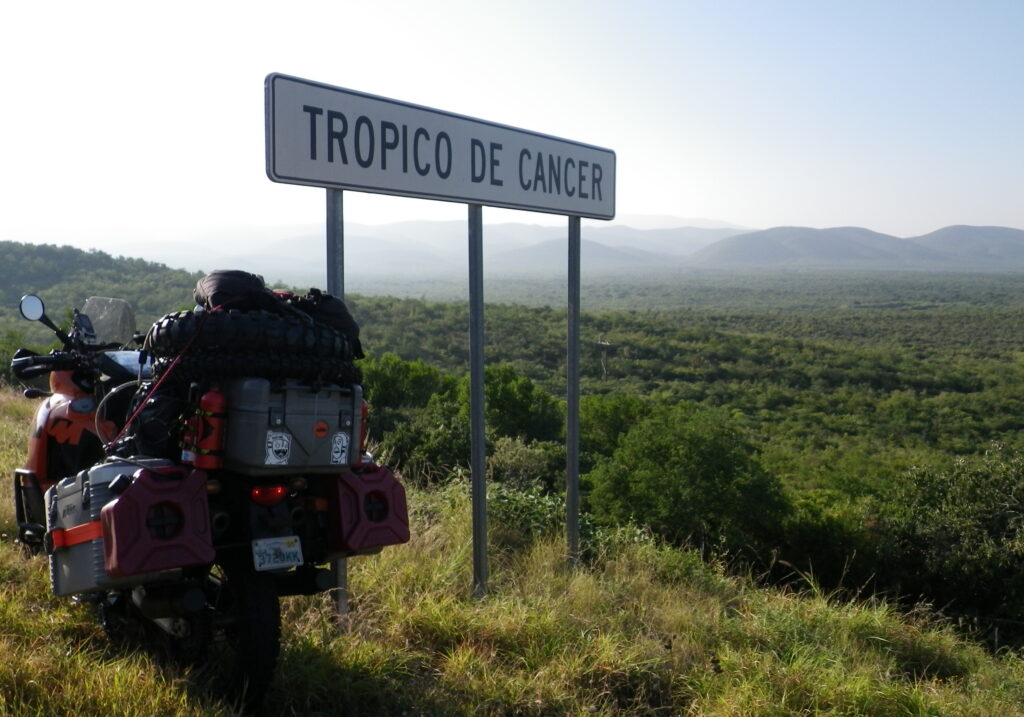
It’s crunch time. I see a man on the side of the road with his truck, cutting tall grass. I turn around, stop and ask if this is his land, and he tells me it’s not. I ask if he has any friends who have land I may camp on for the night. He thinks for a moment, then says in 5 minutes he will meet me up the road 300 meters. I wait for him, and soon he walks up with his daughter and directs me over a small concrete bridge into the courtyard of what I learn to be his mother’s home. His name is Carlos, and with his daughter, brother, and mother about, it feels very homey. I commit a journal entry in Spanish then have a wonderful night’s sleep in my tent under the starry sky, and awake well rested.
Es mi primera día en Mexico. Cruzé la frontera de Mexico y los Estados Unidos por la mañana temprano. Mi moto cayó en el aparcamiento de aduana. Acorté el soporte poco después. Matamoros es una ciudad grande con muchos soldados. Fuí asustado al principio, pero cuándo leí ellos más, empezé a sentir seguro. Sin embargo, no me gusta fusiles de gran potencia apuntado a me. Manejo por ocho horas antes de veo un hombre en el arcén de carretera. La puesta de sol es en treinta minutos. Para trabajando y pregunto sí aquí es su tierra y puedo acampar por la noche. No es su tierra, pero me permite acampar detrás la casa de su madre, a cien metros. Se llamas Carlos. Sabe un poco inglés, pero es bueno. Me gusta a practicar conversación en español. “Con mucho agradecimiento, gracias”. Es una noche despejar y fresca. Duermo profundamente.
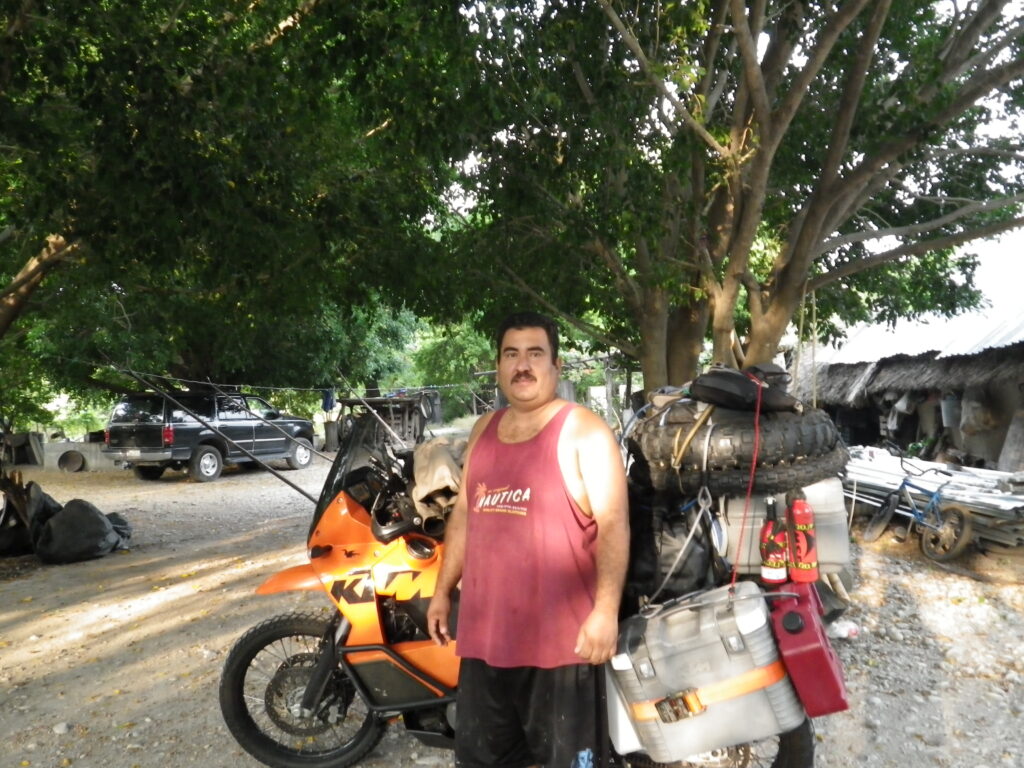
The morning is cool with a foggy haze hanging in the air. It looks like storm clouds, but without a drop of rain. The densely vegetative hills are fun to drive with the weather this perfect. The sun finally breaches the clouds and by noon it’s hot again. Stopping for gas in Tampico I notice a few restaurants across the street. I take the opportunity to refuel myself after my bike and pull up to see what they offer. The first one only serves meat dishes. The next one I come to has a kitchen full of smiling women. When I say I’m looking for a meal without meat, they start talking and devising a meal they can prepare for me. I can’t describe all that’s there, but from what I gathered, it consists of at least tortilla, beans, rice, lettuce, tomato, cow cheese, with salsa and pickled carrots on the side. After speaking with the owner and an employee about my travels for the entirety of my meal, I ask the price with the intention of getting back on the road. He says it’s complimentary and to have a safe trip.
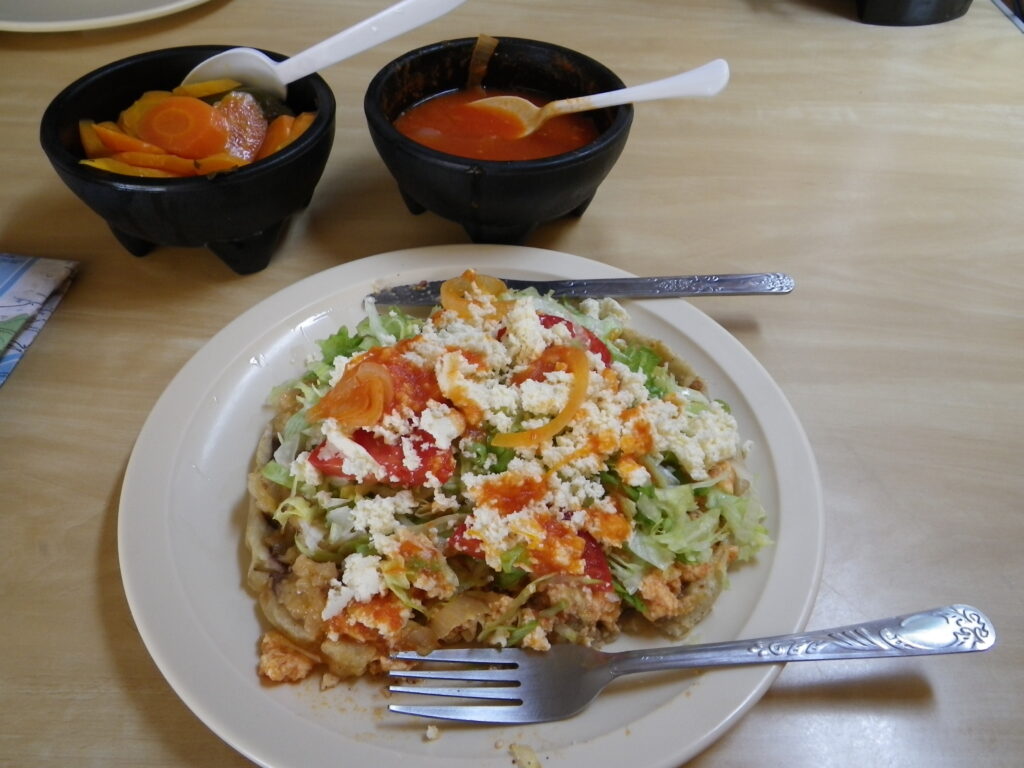
I want to at least see the larger cities of Mexico, but when I arrive at Tuxpan, without wanting to leave my bike unattended, I quickly make the decision to just pass through. The more south I get, the more disparaging some towns I go through become. Piles of garbage, houses built out of sticks and palms, roads with potholes the size of my bike, raw sewage flowing on the side of the street, and children selling food/wares and begging for change at topes (devils of speedbumps).
Poza Rica in Veracruz is the last city I encounter this day. It’s deathly hot and I think it’s time to find a hotel to scrub away the slime I’ve been accumulating the last 3 days and wash my clothes. I find Hotel Nuevo Leon, and happily pay the 200 pesos for the night. I’m spent. I make a call to Sara in Atlanta and end up spending more than an hour talking, racking up a bill that’s more than the cost of my hotel room. It was worth every peso. I’ll probably be more conscious of the time in the future, but for now I needed it. I have an amazing luke-warm shower, then wander around the street of my hotel. I find a shop across from the hotel, Jugo de Piña, which makes smoothies from an assortment of fruits. I choose banana, mango, and pineapple, and take it up to my room to relax over my journal.
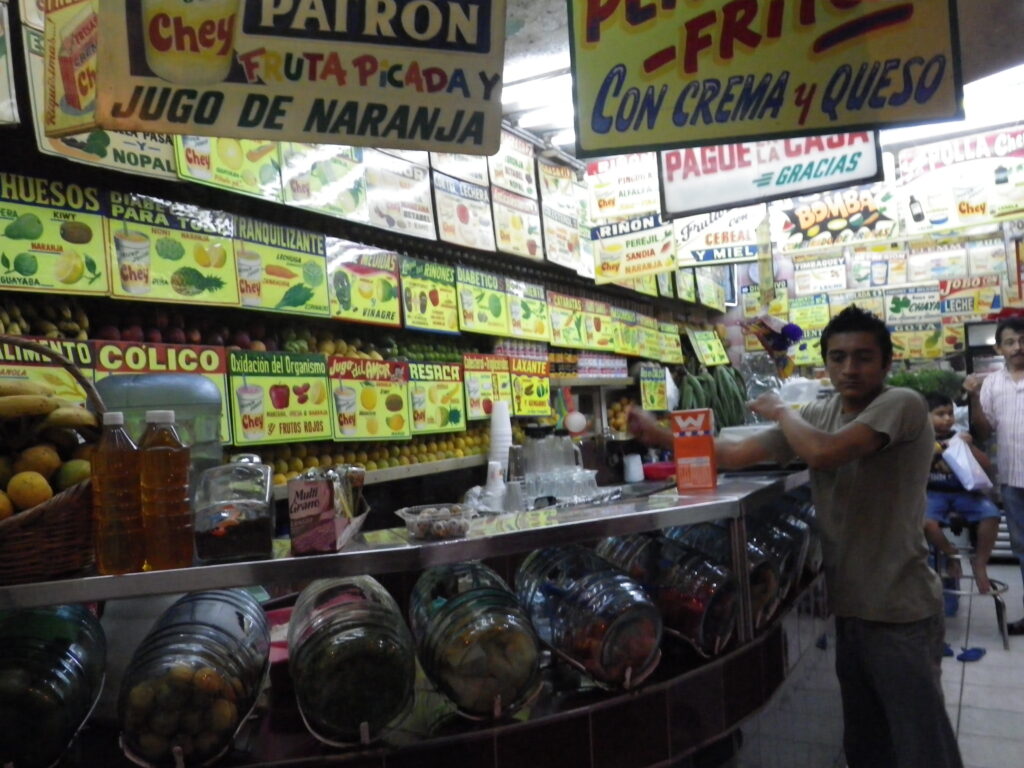
I get an early start on the road to enjoy the cool weather before the sun gets high. I’ve been lucky to have such good weather, but that’s about to change. I decide to bypass Veracruz, as I found a reason I’ve been having my bike overheat more often than I’m used to is because my radiator fans aren’t turning on. I try to keep up my speed to stay cool. I find the topes in towns are good at slowing down trucks so I can pass ahead. I’ve had to stop at least three times in the past few days because of overheating in crawling traffic. It usualy occurs in cities during rush hour (many times during the day/night), at construction zones, and backups at topes. Today’s ride takes me through higher mountains and thick forests. While my pictures are lacking, that just means the roads were thrilling enough that I didn’t think It safe take my hands off the handlebar.
I call it at day at Alvarado. I’d like to communicate back home, make a post, check my bank account, etc., so I ask around Alvarado for a hotel with internet and am soon referred to Hotel María Isela. No sooner after I unload my gear into my room and ask about a restaurant that serves fish, does it start pouring. There’s a break in the rain and I take the opportunity to try to navigate to this restaurant. I get a little lost, but a helpful guitar player on the street directs me the right way. I’ve worked up an appetite since morning, and I order grilled fish and seafood soup, containing mussels, octopus, shrimp, and unidentifiable other sea-life.
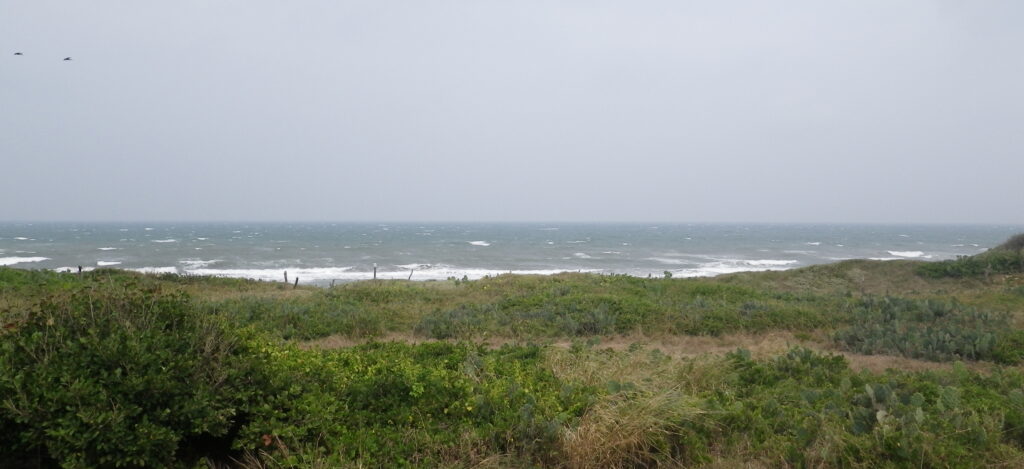
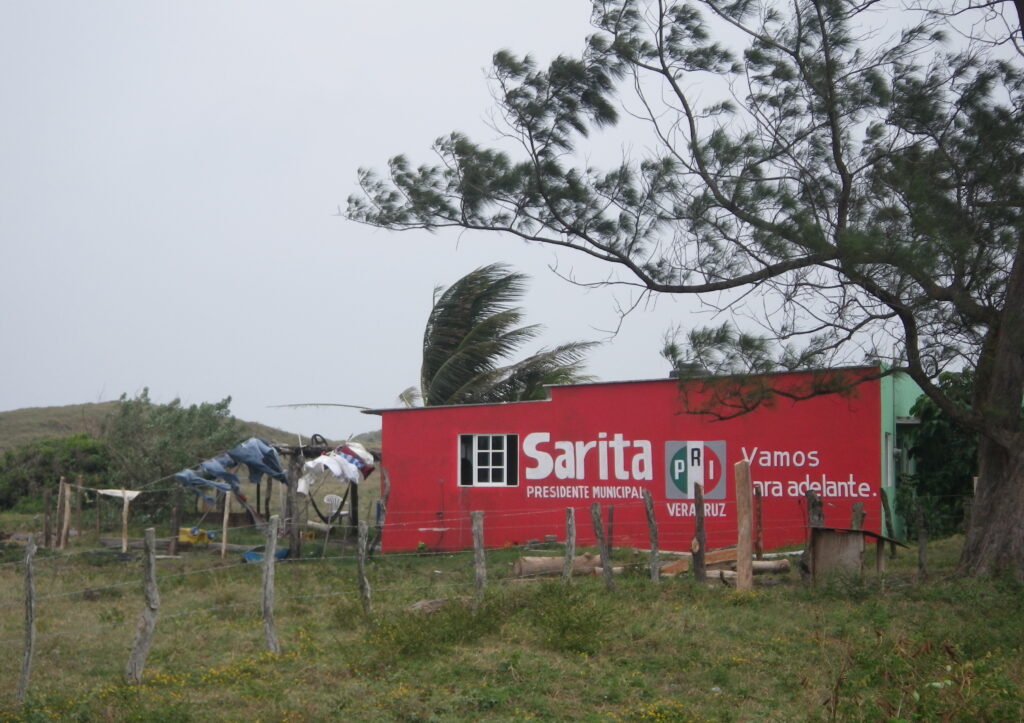
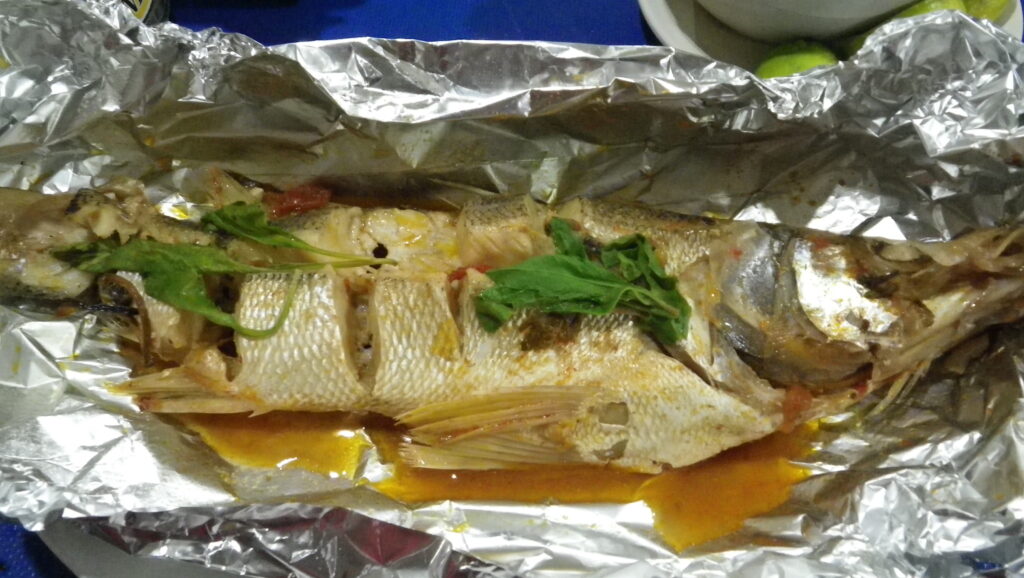

Wow! Looks like your off to an adventurous start! keep the stories coming Kyle. :)